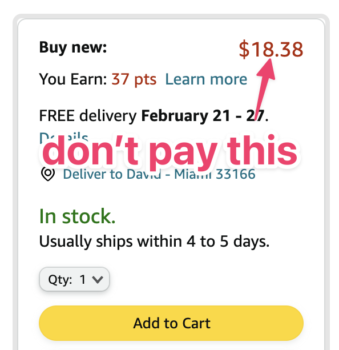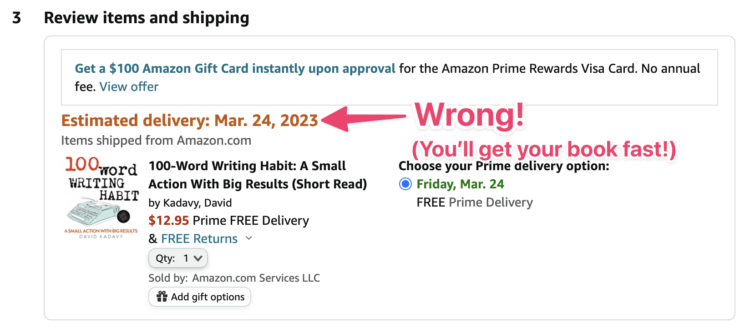Subscribe to blog updates via email »
January 2023 Income Report
An audio version of this income report is available to Patreon backers of certain levels »
January’s income was $11,279, down from December’s $16,325. Profits were $7,898, down from December’s $8,395.
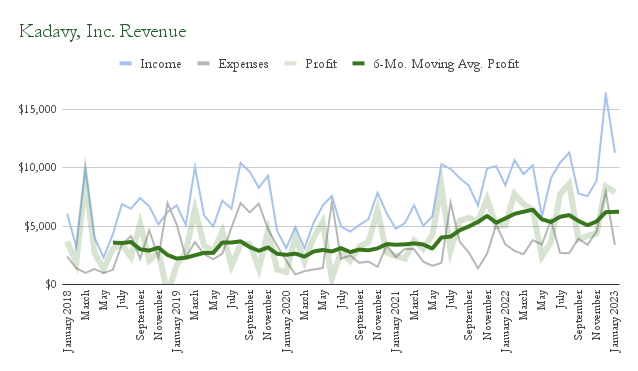

WANT TO WRITE A BOOK?
Download your FREE copy of How to Write a Book »
(for a limited time)
Record yearly revenue, profit, and book sales
Before last month, this month would have been just shy of record-breaking income. But, I’m still breaking other records this month.
This month caps off a twelve-month period of record revenue. I’ve made $118,806 of revenue in the past year. This is the fourth month in a row I’ve broken that record.
This month also caps off a twelve-month period of record profit. I’ve made $72,089 profit in the past year. Naturally, I’ve made a record average profit as well, at $6,007.
I’ve also made record revenue on books in the past twelve months. The $89,596 I’ve made continues a sixteen-month streak of record yearly book revenue. I’ve made record profit on books in the past twelve-months, albeit not in a streak. I’ve made $56,486 in profit on books in the past year, which naturally brings a record monthly average of $4,707.
After some bumps, my average self-published book profits continue to climb.
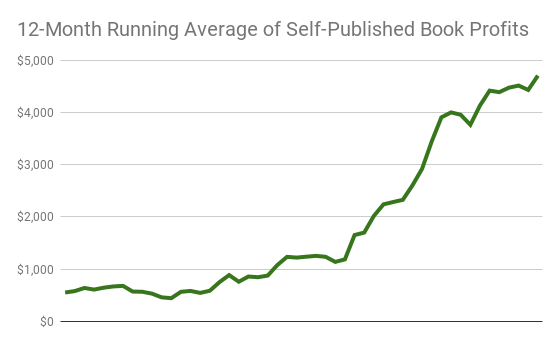
Record monthly book sales
Those are all yearly records, but I’ve also made a monthly record this month. This month, I made $10,450 from book sales, which is a record. Maybe some of those sales are from all the extra money I spent on advertising at the end of the year, because I made all those sales with not a lot of advertising, which led to a record profit from books, of $8,149.
Record MMT income and profit
Those record book numbers come predominantly from sales of Mind Management, Not Time Management which – more than two years after release – continues to increase in sales velocity. I made $8,577 from MMT, with $6,645 profit.
Sales of MMT continue to trend upward.
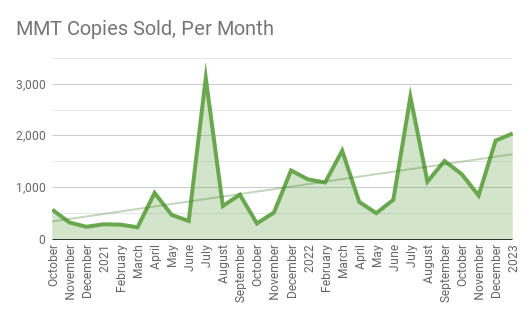
I recently raised the price of the Kindle edition back to $9.99, after months at a lower price, so this graph will probably dip again soon.
100 Word Writing Habit still not in-stock
I continue to have problems with Amazon keeping my new short read, 100 Word Writing Habit, in-stock – at the correct price, at least. Currently, the default “buy” button is attached to a third-party seller who has marked the book up about 50%,
Meanwhile, Amazon itself, which has the book listed at the correct price, is relegated to the “Other sellers” buy button.
Why would Amazon list themselves below a third-party seller, who, no less, is selling the book for 50% more? Ship date. After you put the book in your cart, you see a ship date about three weeks out, while this third-party seller is listed as shipping in 2–3 days.
As far as I can tell, this ship date is wrong. Readers have reported that they’ve received the book within a few days of ordering. The books are distributed, print-on-demand, through IngramSpark. Of course, there’s no way for anyone browsing on Amazon to know that.
As I’ve mentioned before, this kind of stock issue is typical of working with IngramSpark. It tends to work itself out over time, though this is my first time fulfilling a book entirely through IngramSpark, without a Kindle edition to drive sales. It seems to be taking longer than usual to get fixed.
Have tried changing IngramSpark wholesale discount
As I mentioned last month, I changed my terms in IngramSpark to allow returns, which seems to have triggered to at least make the book available. I’ve since changed my wholesale discount from 30% to 35%, to see if that will trigger Amazon to keep some copies in stock, thus fixing this pricing/stock issue. 39 copies have been ordered in the past 7 days, so maybe some of that is Amazon ordering to keep the book in stock.
Trying out direct sales with Bookvault
This issue has been a kick in the pants to get me thinking a bit more about direct sales of physical books. I’ve since uploaded 100-Word Writing Habit to Bookvault, who thankfully provides custom trim sizes, and integrates – on a limited basis – with Payhip.
So, 100-Word Writing Habit is now available direct from me, through Payhip and Bookvault – for customers in the U.S., UK, and Canada. I haven’t yet promoted this, as I’m still waiting for my own first order to arrive to my mailbox. The books are printed in the UK, and supposedly injected into USPS within forty-eight hours – according to a Bookvault representative I spoke to at 20 Books to 50k. But looking more closely at Bookvault’s options, that’s if I’m willing to pay nearly 3x my usual production price. Standard printing time is nearly two weeks!
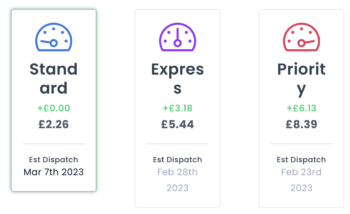
Even after that, I don’t know how long they take to ship. USPS sucks, unfortunately. If I’m promoting direct sales through this avenue en masse, I’d like to be able to provide customers with tracking numbers. I haven’t figured that out yet. Also unfortunate, in my experience, USPS commonly marks packages as delivered when they, in fact, have not been.
Including the proper shipping costs in order prices when integrating Bookvault with Payhip is limited. You have to manually set up rules for how shipping costs differ, based upon an order’s weight or price. But shipping costs from Bookvault can vary wildly, with additional books sometimes not affecting shipping costs by much, sometimes a lot, and sometimes even reducing shipping costs. To simplify things, I have marked the book up a couple dollars, and provided free shipping. The more copies I order, the more profit I end up making, so if you’re reading this and want to order ten or more copies, get in touch and I’ll set up a coupon for you.
The one cool thing about selling directly with Bookvault is the money is available nearly as soon as a book is ordered – rather than waiting 90 days for Amazon or IngramSpark to pay me, like with other books. I also pay the printing and shipping costs, which could be viewed as a downside, but it also means more credit card points and higher revenue numbers, so that’s also kind of cool?
Fulfill through Amazon Seller Central/FBA? (nope!)
With Bookvault printing and shipping as slow as it is, I also considered storing and fulfilling my books through Amazon Seller Central/FBA. But quickly entering numbers into the calculator showed that nearly all my profit would be eaten up – in a best-case scenario. And this is printing 100 copies at Bookvault’s slower and cheaper “Standard” production rate.
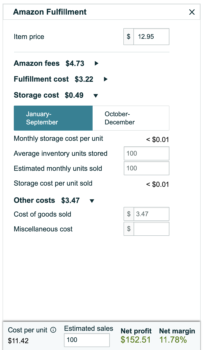
I guess I could try adding a couple bucks to the price, which would still cut my profits down, and ship some books to FBA, ready to be purchased. It really is amazing how cheaply and quickly Amazon is able to get my books to you when everything is working well. I’m so glad I’m dealing with these issues on a “short read”, rather than on some massive book on which I’ve spent years. One of many good reasons to experiment with shorter books.
100-Word Writing Habit sales predictions
Before I made 100-Word Writing Habit available – I’m avoiding the word “launch” because I haven’t been able to launch it – I made some predictions about its sales. I predicted 70% confidence it would sell between 400–800 copies by the end of April. At the time I made that prediction, I didn’t anticipate my Amazon in-stock issues would last this long. These issues have caused me to pause promotions I had planned for the book.
I didn’t use a very sophisticated model for this prediction. I made a rough estimate based upon early sales of Digital Zettelkasten, the positive signals I continue to get from subscribers to my 100-Word Writing Habit email course, and the fact I consider this book idea to be a Gray Swan: It has elements people might find through search, but is a relatively bold idea which has potential to go viral. I haven’t made a 10%-confidence prediction of sales, but I do think the potential is high.
Despite these troubles, I’ve still managed to sell 126 copies of 100-Word Writing Habit. How did I do that? I’ve been keeping subscribers from the email course updated on the book’s in-stock status, I mentioned it in last month’s income report, and I’ve shared it a bit on Twitter. Given I haven’t “launched” the book, I think that’s pretty good. I’m tempted to increase the confidence of my sales projection, but given my ongoing issues keeping the book in stock, I’ll keep it where it is. Additionally, I’ve learned in the past that sales generated on Amazon don’t track to sales reported on IngramSpark on a one-to-one basis. Bulk orders occur in spurts, as retailers stock the book.
Meditating 60 hours in 60 days (again)
I feel I can directly attribute both Digital Zettelkasten and 100-Word Writing Habit to one thing: Naval Ravikant’s meditation challenge, or meditating 60 hours in 60 days. As I’ve talked about in my article, one thing I noticed while spending so much time each day doing “nothing,” was that ideas I’d normally ignore took on more presence in my mind. I think this is from a combination of not being as distracted with spending my entire day working on other things with clearer payoffs, having an hour a day in which I let my mind wander, and simply being more relaxed – which is conducive to creativity.
In retrospect, Digital Zettelkasten and 100-Word Writing Habit don’t feel like that bold of ideas, but they both felt like leaps at the time. Why spend time writing a book on a weird note-taking methodology? Why go through the work of making yet another email course to encourage people to build such a seemingly-insignificant habit? Why do either of these things when I had just launched my biggest book in ten years?
The sensible thing would have been to dedicate myself fully to marketing that big book. But instead I made these small bets I saw as having big potential upside. Digital Zettelkasten was a surprise hit, and marks the point at which my revenue started to climb. 100-Word Writing Habit marks the point at which I stopped losing email subscribers, and started gaining. It’s impossible to know what the outcome would have been if I had used the energy I dedicated towards these projects towards instead marketing Mind Management, Not Time Management, but both of these, no doubt, also had the effect of driving sales of that book, anyway. I guess that’s why those ideas don’t feel as bold in retrospect – because they actually worked.
A transformative experience (the first and third time)
The first time I meditated 60 hours in 60 days, I actually went for eighty-nine days. It was a transformative experience. I also did the challenge a year ago, and don’t remember much about it. But, I’m doing the challenge again. I’m currently on day forty-five.
This time around, it again feels like a transformative experience. Around day forty, I sunk into a state of relaxation that borders on sedation – much like I felt after the first week of my first challenge. I feel like I’m slowly re-animating, as I carve neural pathways that make me functional in this sedated state, rather than whatever more-anxious state in which I normally operate.
I don’t know why the first and third time doing this challenge are impactful, while the second was so forgettable. It might have something to do with coming down from highly-charged experiences. The first challenge I did after finishing MMT, still recovering from the death of my mother and a hard year full of emergencies, keeping my father alive, plus that traumatic first year of the pandemic. This time, I’m settling into a big life change after buying and moving to a cabin in the country, and that everlasting-gobstopper that is grief lingers with a different flavor.
Some people think it’s wrong to expect something from meditation, which strikes me as an idealist and dishonest take that maybe I’m not enlightened enough to understand. But anyway, I’m doing it, I’m benefitting, and I think that’s okay.
Foreign-rights galore!
The foreign-rights deals are flowing in. At one point, I realized I had five pending deals in my inbox. For Mind Management, Not Time Management , I’ve signed a Turkish deal and am waiting for payment, I’m waiting for a counter-signed agreement for Vietnamese, and I’m in talks with a publisher in India for the Hindi and Marathi rights, and am still waiting to hear back from an Indonesian publisher. The publisher that inquired about Thai rights has disappeared, and the Japanese publisher decided not to make an offer. Weirdly, a publisher in India wanted rights to distribute in English, and inquired about making significant changes to the book. I never heard back from them. I made a deal for the Arabic rights back in May – I don’t know when that will be released.
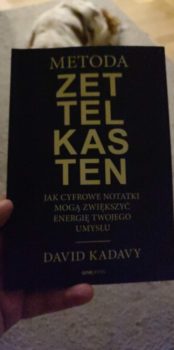
Meanwhile, a reader has sent me a photo of the Polish version of Digital Zettelkasten, and I’m trying to get the publisher to send my author copies. I signed the deal for Korean rights in July, so that must be in-progress. Almost two years have passed since I signed the contract for the Vietnamese version of The Heart to Start. Our contract stipulated that rights reverted back to me if it wasn’t published within eighteen months. I had trouble getting a response from the publisher, but they have assured me they’re working on it.
I’m figuring out foreign-rights as I go. I had an agent on the Korean deal – they reached out to me – but all the other deals I’ve negotiated and signed myself. I had an agreement with an agent in China that has lapsed with no deal – despite inquiries through that agent in other languages. The Japanese MMT deal would have been through an agent, too. I think they’re still shopping it around.
Lessons-learned after $10,000 in foreign-rights deals
So far, I’ve signed nearly $10,000 in foreign-rights deals. I want to say that’s lots of free money, but it’s required a non-trivial amount of asking around, reading contracts carefully, and following up with publishers again and again. (The Boomerang Gmail plugin is invaluable for this.)
A few things I’ve learned – not legal advice:
- Don’t bother trying to make deals happen. Sell lots of books in English, and foreign-rights deals will come.
- Don’t bother leading your own translation. If you don’t know how to market a book in that language and territory, you will fail.
- Counterintuitively, it’s harder to get a deal for a popular language such as Spanish, French, or German. I’ve never had an inquiry in those languages.
- Terms are usually for five years
- They might as well be worldwide rights if a language is generally spoken in one territory
- Royalties are 6%–9% for paper books and 25% for ebooks and audiobooks – but it’s not uncommon for a publisher to only do paper. I’ve heard as high as 12%, but haven’t gotten it.
- The publisher usually states a desired first print run and list price. Don’t bother negotiating this amount – they know their markets.
- Advances range from a few hundred dollars for a thousand-copy print-run (India), to $4,000 for a few-thousand-copy print-run (Korea)
- List prices for me have ranged from $3 for a 260-page book (India), to $11.50 for a 75-page book (Korea)
- From that royalty and list price, you can calculate how many books they’d need to sell before you earn out that advance. The number is usually a little more than that first print run. (I made a spreadsheet calculator.)
- My best deal has been from an agent, who got 10%. Maybe I need to negotiate harder?
- In the Saudi Arabian market (Arabic), terms were based per print run (e.g. $1,200 for the first 2,000, $750 per 1,000 thereafter) – thus no royalty rate.
- Lots of authors are paranoid about scams. But if the domain and reply-to address of the inquirer is a legit publisher and they have a LinkedIn profile proving their position, what’s there to be scared of?
- It’s not uncommon for a legit publisher to ask for a PDF of your whole book. Yeah, this is kinda scary. Fortunately, I do my own layout, and can easily watermark every page with the publisher’s name.
- Lots of people recommend a lawyer. This is not legal advice, but I figure: I can read the contract, I’m clearly not giving away English rights, why hire a lawyer for a $1,000 deal?
- Will you ever receive more than your advance? I’ve heard mixed stories. Some authors (on the 20 Books to 50k Facebook Group) say they’ve never not received more than the advance. Some have said the opposite. The publisher is in another country, so it’s easier to get away with not paying.
- It might be a good idea to get the highest advance possible, without worrying about the royalty rate
- Maybe an agent would help you collect further payments (they have long-term relationships with publishers). But some authors claim every agent has stolen from them.
Okay, that’s more than a few things. I don’t know much, but those are the things I know (and don’t).
YouTube video-podcast experiment
A prediction I made about the video versions of my podcast on YouTube turned out to be true. I felt 70% confident my two January episodes would average more than my audio-only episodes, by the end of February. Well, it’s not quite the end of February, but my two video episodes from January have surpassed that mark – though not by much. The number they needed to beat was a measly 37 views. The actual average between the two videos: 50.
Will I keep doing video podcast episodes?
That’s nothing to get excited about, especially considering that recording, editing, and publishing these video versions takes a few extra hours each month. And that’s to make plain talking-head videos, with none of the B-roll, animations, music, graphics or zooms in and out that YouTube viewers have come to expect.
I looked into hiring help to edit and add some basic flair to my videos, and the one quote I got came to $1,200 per month, for two 15-minute videos. That’s too much to spend for content that isn’t designed to be on YouTube from the start. I mean, what would I get – 75 views, instead of 50?
The stand-up comedy model of content
This experiment has helped me realize that since I think of my podcast as sort of an “open mic” – or at least a set at the Omaha Funny Bone – there’s no point in putting a lot of resources towards adding visuals to go with the content.
The better investment for my video buck, I think, is my reels, which I’m posting on TikTok, Instagram, Facebook, and YouTube. If my podcast is an open mic, these are my “tight five” – stuff I mostly know works. Presenting one idea in a minute or less is a useful exercise for tightening my messages. Perhaps if I get really good at creating video content, I can upgrade to doing more content for YouTube.
Why “repurposing” podcast recordings for social media doesn’t work
The standard wisdom is, if you’re recording a podcast anyway, you might as well shoot video, because you can cut it down into social media clips. I don’t agree with this. If you’re making content meant to be presented in fifteen minutes, you won’t necessarily find a thirty-second or minute-long clip that will work on a platform such as TikTok. Just look at this TikTok engagement graph:
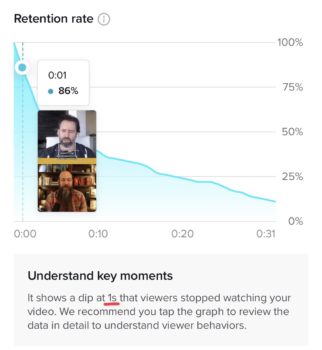
TikTok’s analytics will tell you with a straight face that your video is losing engagement at one second, and you need to improve your content. Yes, this begs the question, Should I bother with a channel on which people have such short attention spans? That’s a good question, but for now I’m enjoying the challenge.
Even when I cut down a clip from a podcast recording to its most-essential elements, it doesn’t perform as well as if I make a video that’s built for TikTok from the ground up. The medium is the message, and you have to adapt the message for the medium.
If my fifteen-minute podcast episodes don’t have engaging one-minute clips embedded in them, maybe my writing needs to improve? That’s a plausible point, but I’d rather improve my writing by writing and producing short videos just for TikTok than chopping up fifteen-minute video clips into smaller ones.
A couple more videos coming up
I nearly cancelled this third month I’m going into of this three-month experiment, after I saw what it would cost to do YouTube right, and thought about where better to expend my energy. But, at least one of the episodes I have planned for March just begs to have visuals. So, I’m cutting together a basic video that’s almost doing YouTube “right,” and I recorded the second episode of the month while I was at it. I have to say, though, I still find recording and editing video kind of fun.
Experiment take-aways
This experiment with shooting video versions of my podcast has reminded me to invest in messaging, not marketing. When I invest time, energy, or money in producing content, the question I need to ask first is, “Will this improve my communication?” Making reels does, shooting talking-head videos of my podcast does not.
Thank you for having me on your show!
Thank you for having me on your shows. Thank you to Ajay Mathur at Be Yourself. As always, you can find all interviews of me at kadavy.net/interviews.
Income
Book Sales
| Mind Management, Not Time Management Kindle | $1,337 |
| Mind Management, Not Time Management Paperback (Amazon) | $3,281 |
| Mind Management, Not Time Management (non-Amazon) | $2,234 |
| Mind Management, Not Time Management Audiobook | $1,725 |
| 100-Word Writing Habit | $78 |
| Digital Zettelkasten Kindle | $662 |
| Digital Zettelkasten Wide (non-Kindle) | $182 |
| Digital Zettelkasten Audiobook | $62 |
| The Heart to Start Kindle | $152 |
| The Heart to Start Paperback (Amazon) | $181 |
| The Heart to Start “Wide” (non-Amazon) | $187 |
| The Heart to Start Audiobook | $58 |
| How to Write a Book Kindle | $84 |
| How to Write a Book Paperback | $184 |
| How to Write a Book “Wide” (non-Amazon) | $15 |
| How to Write a Book Audiobook | $11 |
| How to Write a Book Spanish (all) | $5 |
| Make Money Writing on the STEEM Blockchain (all) | $3 |
| Ten Passive Income Ideas | $7 |
| Total Book Sales | $10,449 |
Digital Products
| Summer of Design | $9 |
| White Hot Course | $39 |
| Total Digital Products | $48 |
Affiliates / Advertising
| Active Campaign | $454 |
| Alliance of Independent Authors | $0 |
| Amazon | $19 |
| Hostgator | $100 |
| SendOwl | $5 |
| Total Affiliates | $578 |
Love Your Work Podcast
| Patreon | $198 |
| Total LYW Podcast | $198 |
Services
| Clarity | $0 |
| Medium | $6 |
| Total Services | $6 |
| GROSS INCOME | $11,279 |
Expenses
General
| Accounting | $563 |
| Outside Contractors | $0 |
| Podcast Editing / Publishing | $123 |
| Quickbooks | $49 |
| Total General | $735 |
Advertising
| Amazon | $2,163 |
| BookBub | $138 |
| Total Advertising | $2,301 |
Hosting
| ActiveCampaign | $135 |
| Bookfunnel | $15 |
| Drafts | $2 |
| Dropbox | $10 |
| Fathom Analtyics | $14 |
| Libsyn | $7 |
| Namecheap | $15 |
| SendOwl | $9 |
| Typeform | $26 |
| Ulysses | $3 |
| WP Engine | $96 |
| Zapier | $14 |
| Total Hosting | $346 |
| TOTAL EXPENSES | $3,381 |
| NET PROFIT | $7,898 |

